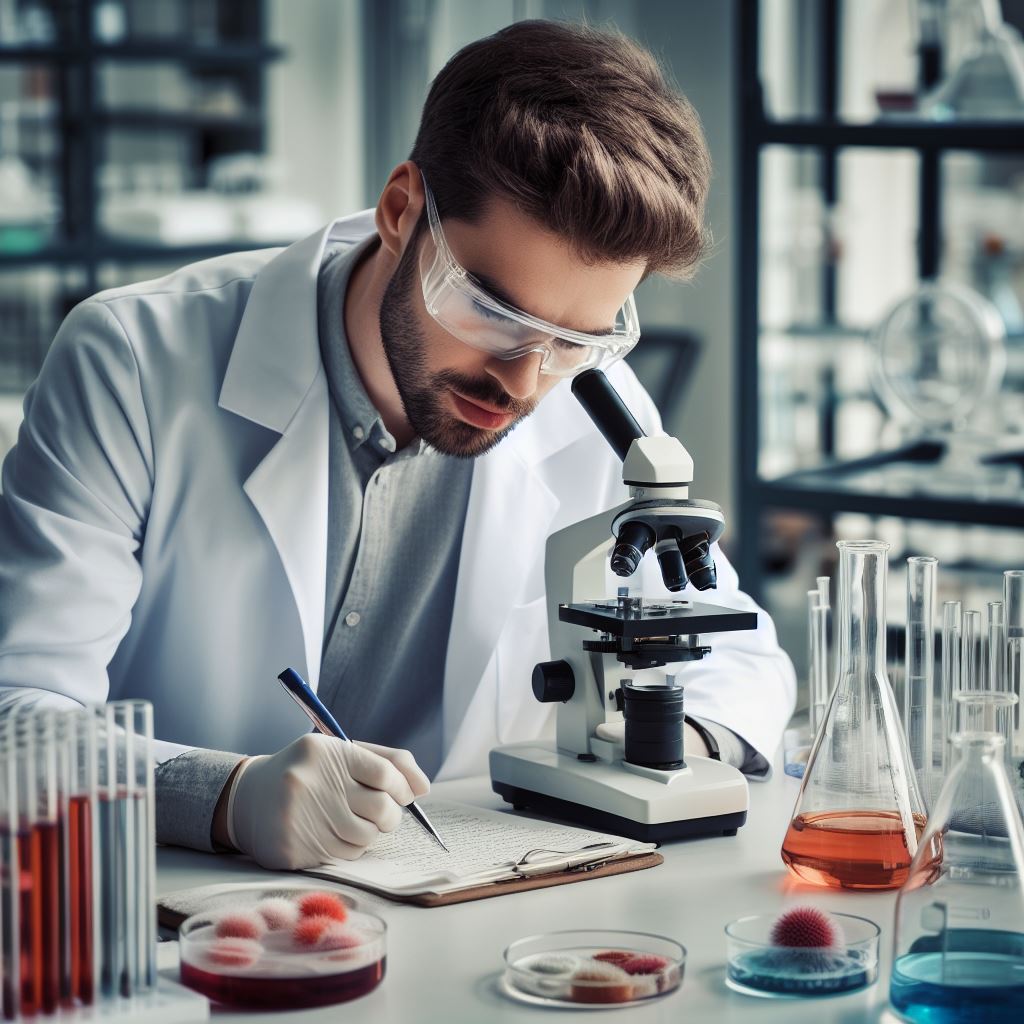Introduction
Brief explanation of the role of a biologist
A Biologist’s Toolkit plays a crucial role in understanding and unraveling the mysteries of the natural world. They study living organisms and their interactions with the environment.
In order to conduct their research effectively, they rely on the right equipment and technology.
Having the right equipment and technology is of utmost importance for a biologist. It enables them to collect accurate data, make precise observations, and analyze samples efficiently.
The field of biology encompasses a wide range of research areas, from studying animal behavior to investigating microorganisms.
Importance of having the right equipment and technology
Biologists require various tools and instruments to carry out their work. These may include microscopes, centrifuges, pipettes, DNA sequencing machines, and field sampling kits.
Each tool serves a specific purpose, allowing biologists to examine specimens, analyze DNA, and collect samples in different settings.
In addition to equipment, technology plays a crucial role in modern biology. Biologists heavily rely on advanced computer software, data analysis tools, and molecular techniques.
These advancements have revolutionized the field, allowing for faster and more accurate research outcomes.
Having access to the latest equipment and technology is essential for biologists to stay at the forefront of their field.
It enables them to conduct cutting-edge research, discover new species, understand complex biological processes, and contribute to scientific advancements.
In review, the role of a biologist is crucial in unraveling the mysteries of the natural world.
With the right equipment and technology, they are able to carry out their research effectively and make meaningful contributions to scientific knowledge.
Read: Job Outlook: Future Demand for Biologists in America
Basic Equipment for Biologists
Biologists rely on a variety of equipment to conduct their research and experiments.
These tools are essential in helping them observe, study, and analyze the biological world. In this section, we will explore some of the basic equipment used by biologists and their importance in the field.
Microscopes
Microscopes are one of the most fundamental tools in a biologist’s toolkit. They allow scientists to magnify and study microscopic organisms or structures in detail.
Different types of microscopes, such as compound and electron microscopes, have their unique uses and applications.
For instance, compound microscopes are commonly used in cellular biology, while electron microscopes are utilized for studying ultra-small particles.
Lab Coats and Safety Gear
Safety should always be a top priority in any laboratory setting, and biologists are well aware of this.
Lab coats and other safety gear, such as goggles and gloves, are crucial in protecting scientists from hazardous chemicals, biological agents, or accidental spills.
Wearing this protective gear minimizes the risk of exposure and ensures a safe working environment.
Gloves and Masks
When handling biological samples or working with potentially infectious materials, biologists wear gloves and masks.
These protective items not only prevent contamination of the samples but also safeguard the biologist from exposure to harmful pathogens.
By using gloves and masks, researchers can carry out experiments without risking their health.
Scalpels and Dissection Kits
For biologists working with larger organisms, such as animals or plants, scalpels and dissection kits are essential tools.
These tools enable scientists to collect specimens, make precise incisions, and conduct detailed examinations.
Whether it’s dissecting an animal for anatomical study or taking samples for genetic analysis, scalpels and dissection kits are indispensable in these processes.
Field Guides and Notebooks
Biologists often work in the field, exploring natural habitats and conducting research outside of the lab.
Field guides and notebooks play a crucial role in documenting observations, collecting data, and recording important details.
Field guides help identify different species and provide valuable information, while notebooks allow biologists to organize their findings and make accurate observations.
These are just a few examples of equipment that biologists use daily to carry out their work. Remember, the tools are only as good as the skills of the biologist using them.
Proficiency in handling and utilizing these tools is necessary to ensure accurate and reliable results in the field of biology.
So, whether it’s observing microscopic organisms under a microscope or conducting field research with a notebook in hand, the equipment a biologist uses is an integral part of their profession.
By employing these tools effectively, biologists can continue to explore and unravel the mysteries of the natural world.
Read: Salary Expectations: Biologists‘ Earnings Across the States
Advanced Technology in Biology
DNA Sequencing Machines
- Play a crucial role in modern genetic research and analysis.
- Capable of determining the order of nucleotides in a DNA molecule.
- Enables scientists to study genetic variations, mutations, and gene functions.
- Empowers researchers to understand the molecular basis of diseases.
Advancements in Genomic Research
- Have led to breakthroughs in understanding the human genome.
- Allows scientists to map the entire DNA sequence of organisms.
- Provides insights into evolutionary relationships between species.
- Aids in the identification of genetic markers for disease diagnosis and treatment.
PCR Machines
- Essential equipment for amplifying DNA samples.
- Enables the production of millions of copies of a specific DNA sequence.
- Used in various applications, such as genetic testing and DNA fingerprinting.
- Helps researchers analyze small amounts of DNA with high precision.
Electron Microscopes
- Provide high-resolution imaging for studying cells and tissues.
- Use beams of electrons to visualize the structures and organelles within cells.
- Enable scientists to observe nanoscale details in biological samples.
- Used in fields like cell biology, microbiology, and neuroscience.
Spectrophotometers
- Used for measuring light absorbance in biological samples.
- Allow quantification of biomolecules like DNA, RNA, and proteins.
- Help in determining concentration, purity, and characteristics of biomolecules.
- Commonly employed in molecular biology and biochemistry laboratories.
Next-generation Sequencing
- Revolutionizing the study of genetics and genomics.
- Allows simultaneous sequencing of millions of DNA fragments.
- Provides faster, cheaper, and more accurate DNA sequencing methods.
- Enables large-scale genomic analysis and personalized medicine.
Generally, advanced technology has significantly enhanced the field of biology.
DNA sequencing machines, PCR machines, electron microscopes, spectrophotometers, and next-generation sequencing techniques have revolutionized genetic research and analysis.
These tools empower scientists to explore the molecular basis of diseases, study genetic variations, and understand the human genome.
With these advancements, the possibilities for discoveries and breakthroughs in biology are limitless.
Read: Becoming a Biologist: Key Steps and Education in the USA

Emerging Technologies in Biology
These emerging technologies have the potential to revolutionize biology and drive breakthroughs in various scientific fields.
The development and application of these tools and techniques have opened up new avenues for research and discoveries.
Transform Your Career Today
Unlock a personalized career strategy that drives real results. Get tailored advice and a roadmap designed just for you.
Start NowCRISPR-Cas9
- Revolutionary gene editing tool with potential applications in various fields.
- Allows for precise modification of DNA to correct genetic defects or introduce desired traits.
- Used in research to study gene function and develop new therapies for genetic diseases.
CRISPR-Cas9, in particular, has garnered significant attention due to its ability to edit genes with remarkable precision.
This technology has immense potential in treating genetic disorders, such as cystic fibrosis or sickle cell anemia, by correcting the underlying genetic mutations.
Single-cell Sequencing
- Enables analysis of individual cells at the genomic level.
- Provides insights into cellular diversity, heterogeneity, and cell-to-cell variability.
- Used in cancer research to understand tumor evolution and resistance to therapy.
Single-cell sequencing has transformed our understanding of cellular diversity and heterogeneity.
By analyzing individual cells, researchers can uncover unique characteristics and mechanisms that were previously hidden within bulk cell populations.
This technology has proven invaluable in uncovering the complexity of cancer development and identifying potential therapeutic targets.
Artificial Intelligence in Biology
- Integration of machine learning algorithms in biological research and data analysis.
- AI systems can identify patterns, predict outcomes, and discover new insights from vast biological datasets.
- Used in drug discovery, disease diagnosis, and personalized medicine.
Artificial intelligence is revolutionizing data analysis in biology. Machine learning algorithms can quickly process vast biological datasets, identify subtle patterns, and predict outcomes.
This technology has already made significant contributions to drug discovery, disease diagnosis, and the development of personalized treatment plans.
Synthetic Biology
- Merging engineering principles with biology to design and construct new biological systems.
- Allows for the creation of synthetic organisms, biomaterials, and biofuels.
- Potential applications in healthcare, agriculture, and environmental conservation.
Synthetic biology combines principles from engineering and biology to design and construct new biological systems.
This interdisciplinary field has the potential to create organisms with specific functions, produce environmentally friendly biofuels, and develop innovative materials for various applications.
Nanotechnology in Biology
- Utilizing nanoscale materials and devices for biological applications.
- Enables precise drug delivery, targeted therapy, and sensitive imaging.
- Promising advancements in cancer treatment and diagnostics.
Nanotechnology has enabled precise drug delivery and imaging in biology. Nanoscale materials and devices can target specific cells or tissues, increasing the effectiveness of treatment and reducing side effects.
The use of nanotechnology in cancer diagnostics and therapy holds great promise for improving patient outcomes.
As these technologies continue to advance, we can expect even greater breakthroughs in biology.
They offer unprecedented opportunities to understand biological systems, develop innovative treatments, and solve intricate problems.
The integration of these tools and techniques will undoubtedly lead us into a new era of biological research and transformational discoveries.
Read: Day in the Life: Routine Tasks for a US-Based Biologist
Learn More: Job Market Trends: Future of Chemistry Jobs in America
Delve into the Subject: Ethical Considerations in Paleontological Excavations
Find Out More: Career Progression: From Junior to Senior Hydrologist
Conclusion
The biologist’s toolkit is comprised of essential equipment and technology that play a crucial role in advancing scientific research.
It is vital for biologists to keep up with advancements in the field to stay competitive and improve their work.
By utilizing tools such as microscopes, DNA sequencers, and computer software, biologists can enhance their understanding of living organisms and making,
Significant contributions to various fields such as medicine, agriculture, and environmental conservation.
As technology continues to evolve, it is essential for biologists in the US to adapt and incorporate new tools into their work.
The biologist’s toolkit is ever-expanding, and it is vital for scientists to embrace these advancements and utilize them to their full potential.
By doing so, biologists can continue to push the boundaries of knowledge and make groundbreaking discoveries that benefit society as a whole.
[E-Books for Sale]
The Big Book of 500 High-Paying Jobs in America: Unlock Your Earning Potential
$19.99 • 500 High-Paying Jobs • 330 pages
Explore 500 high-paying jobs in America and learn how to boost your career, earn more, and achieve success!
See All 500 High-Paying Jobs of this E-Book
1001 Professions Without a Degree: High-Paying American Jobs You Can Start Now
$19.99 • 1001 Professions Without a Degree • 174 pages
Discover 1001 high-paying jobs without a degree! Unlock career tips, skills, and success strategies for just $19.99!




